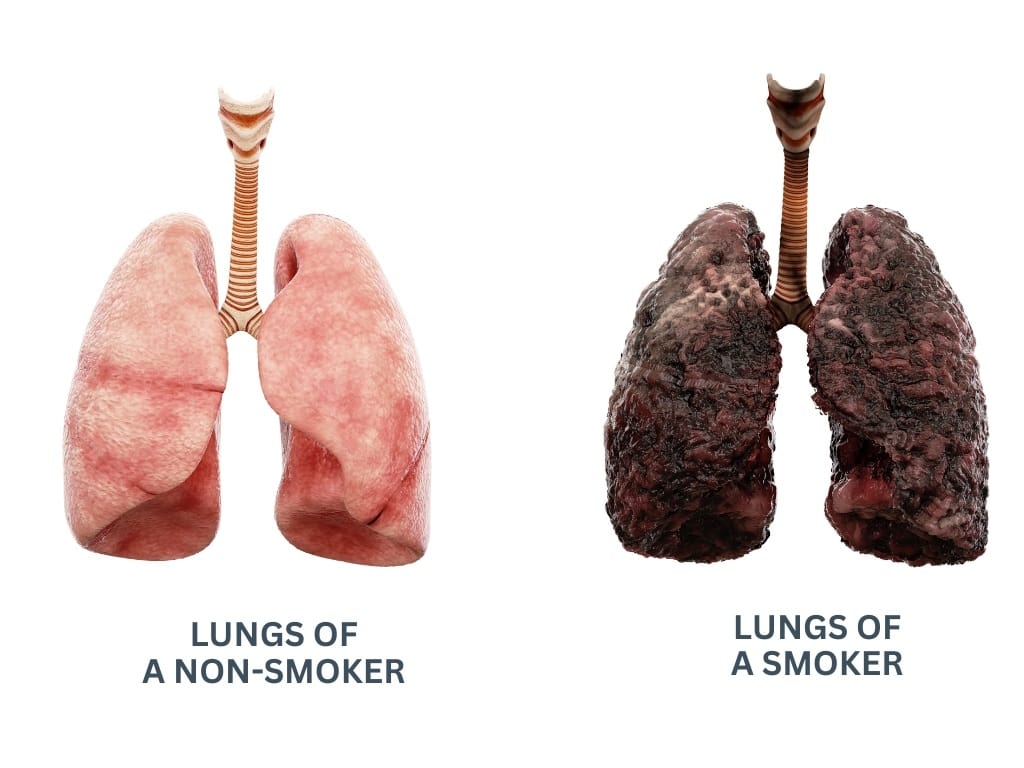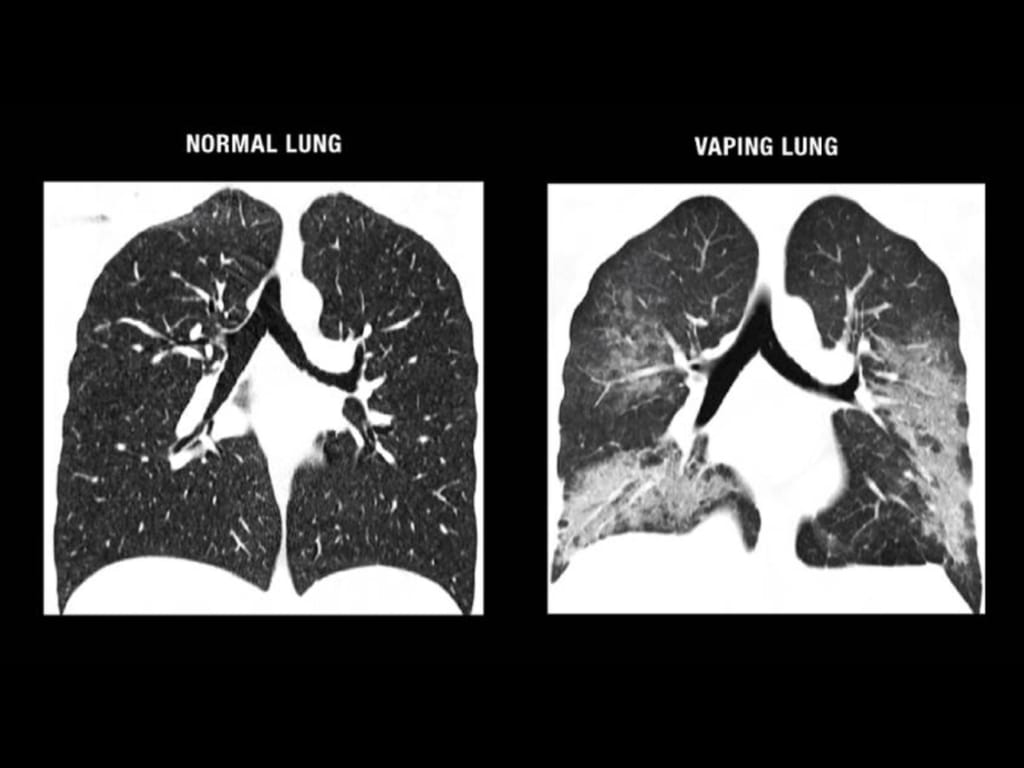For generations, the image of a cigarette has been tied to stress relief, socialising, or even sophistication – amidst a backdrop of anti-smoking campaigns centred on all the ways in which cigarettes and their chemicals can harm you. It’s undeniable that smoking remains one of the biggest threats to respiratory health in the UK and worldwide. And just as today’s culture shifted away from cigarettes in what appeared to be a move towards living healthier, it seems that another harm has taken its place: vaping. While they’re marketed as a cleaner, safer alternative, the truth is more complex, and at The Health Suite Leicester, we focus on separating fact from fiction.
Understanding how smoking and vaping affect the lungs, and the body more broadly is key to making informed choices about your health.
How Cigarette Smoke Damages the Lungs
People assume that the most dangerous part of a cigarette is all the nicotine they’re inhaling. However, the smoke of a cigarette contains more than 7,000 chemicals – and this includes tar, formaldehyde and plenty of other proven carcinogens.
Every breath you take of these toxins, irritates the lining of the lungs and causes inflammation in the body.

Over time, this constant assault triggers permanent damage:
- Chronic bronchitis – this is where the airways become inflamed and it produces a persistent cough often with mucus.
- Emphysema – This refers to the destruction of tiny air sacs (alveoli) that allow oxygen into the bloodstream, leading to severe breathlessness and blackened lungs.
- Lung cancer – the number one cause of cancer is still smoking, and it’s responsible for around 70% of cases in the UK.
And if you thought the damage stopped there, you’re in for more surprises. Smoking also thickens the blood, damages blood vessels, and stresses the heart. It even affects the skin, the brain, and reproductive health. The lungs, however, remain the most visibly scarred.
The Rise of Vaping: A New Story for Old Habits
Just within the past decade alone, vapes have emerged as a healthier alternative to cigarettes because they supposedly contain fewer chemicals. They don’t involve burning tobacco, for example, which gets rid of tar and reduces carcinogen exposure.
Vaping involves inhaling smoke that’s created by heating liquids containing things like nicotine as well as flavourings and solvents. So whilst fewer toxins are present compared to cigarettes, the process still produces aldehydes and small particles that damage the lungs through irritation and inflammation.
There is much emerging research showing that vapes:
- Cause symptoms similar to cigarettes, like coughing, wheezing, and chest tightness in those who use them frequently.
- Modify immune responses in the lungs, so infections become more likely over time.
- Cause irritation in the throat and airways, especially when they’re flavoured.
- Cause some long-term inflammation, which can lead to chronic disease.
Most importantly, however, the long-term effects aren’t yet known. Cigarettes took decades before their dangers were fully understood. With vaping, we may still be in the early chapters of a story that could unfold very differently than promised.
The Hidden Impact of Nicotine
Smoking or vaping both deliver nicotine in the body, which is a substance that may not cause cancer directly but has a major impact on health regardless of this.
That’s because nicotine is:
- Highly addictive – rewiring the brain’s reward pathways and making quitting difficult.
- A cardiovascular stressor – raising blood pressure and heart rate.
- A disruptor of sleep and mood – which can contribute to fatigue, anxiety, and reduced mental clarity.
For adolescents, nicotine exposure is particularly concerning. Early use can “hardwire” the brain for lifelong dependency. This is one reason the sharp rise in vaping among teenagers has triggered widespread concern among health professionals.
Second-Hand Smoke and Vapour Risks
Second-hand cigarette smoke is proven to be dangerous to others, which means it’s not just the smoker or vaper who pays with their health. It increases the risk of asthma, infections, and even sudden infant death syndrome (SIDS) in children.
And while second-hand vapour isn’t as studied as first-hand smoking, research shows that bystanders still end up inhaling nicotine and fine particles. For vulnerable groups such as children, pregnant women, or those with asthma, even “passive vaping” may cause harm.

Can the Body Heal After Quitting?
This is a fact that might surprise you – the lungs are so remarkably resilient when you give them a chance that quitting smoking brings benefits almost immediately:
- After 20 minutes, heart rate and blood pressure drop.
- Within 48 hours, carbon monoxide levels fall, and oxygen delivery improves.
- After 2–3 weeks, lung function starts to increase.
- The risk of coronary heart disease is cut in half in just 1 year.
- The risk of lung cancer is significantly reduced within 10 years.
Stopping vaping also helps restore lung comfort, reducing coughing, wheezing, and irritation over time. The earlier you stop, the more the body can regenerate itself.
Supporting Respiratory Recovery at The Health Suite Leicester
At The Health Suite, we understand that breaking free from smoking or vaping is not just about willpower; it’s about a whole-person approach to healing and recovery.
We support patients with:
- Thorough lung function tests to measure your respiratory baseline and track improvements over time.
- Nutritional strategies using antioxidants, vitamins, and minerals to combat the oxidative stress caused by smoking.
- Advanced treatments from oxygen therapy to red light therapy, designed to boost circulation, repair tissue, and restore energy levels.
We combine science-led strategies with advanced wellness therapies to help you not only on your journey to quitting, but also to help you thrive in the months and years after.
Want to Start Your Quitting Journey?
It’s well known that vaping is less harmful than smoking, but it isn’t risk-free. The long-term effects are still being studied, and e-cigarettes can expose you to chemicals and ultrafine particles that may affect your lungs and heart. Both vaping and smoking also keep you reliant on nicotine — and that dependency places ongoing strain on both body and mind.
Your lungs fuel every cell in your body, driving your energy, focus, and vitality. Protecting them is one of the most powerful investments you can make in your future health.
At The Health Suite Leicester, we provide the expertise, testing, and therapies you need to finally break free from nicotine — whether it’s cigarettes or vaping — and restore your respiratory health with confidence.
Click here to book your appointment with our Private GP Services.

